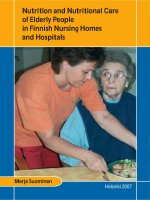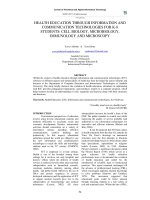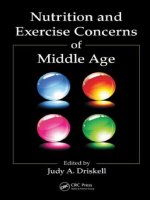Peak Performance Through Nutrition and Exercise pot
Bạn đang xem bản rút gọn của tài liệu. Xem và tải ngay bản đầy đủ của tài liệu tại đây (21.73 MB, 132 trang )
Peak Performance
Through Nutrition and
Exercise
Anita Singh, Ph.D., RD, Tamara L. Bennett, M.S. and
Patricia A. Deuster, Ph.D., M.P.H.
Department of Military and Emergency Medicine
Uniformed Services University of the Health Sciences
F. Edward Hebert School of Medicine
September 1999
Through Nutrition and Exercise i
Foreword
Funding to develop this guide was received from Health Affairs,
Department of Defense (DoD). Our project was one of many health promotion
and prevention initiatives selected for funding. The selection of this project
indicated a need for resources and materials that address the health and
fitness needs of military personnel. We recognize that there are numerous
books, tapes and websites dedicated to physical fitness and performance
nutrition for the general public. However, our goal was to develop a
comprehensive resource that is specifically tailored to address the unique
physical fitness and nutrition requirements of Navy personnel. Our previous
publications include “
The Navy SEAL Nutrition Guide
” and “
The Navy SEAL
Physical Fitness Guide
”. We hope that the nutrition and fitness information
in this guide will help you achieve both your professional physical readiness
and your personal performance goals. A companion guide for use by health
promotion personnel is entitled “
Force Health Protection: Nutrition and
Exercise Resource Manual
.”
ii Peak Performance
Acknowledgments
We would like to acknowledge the following for reviewing the book
entitled “
Force Health Protection: Nutrition and Exercise Resource Manual
”
on which this guide is based:
From Bureau of Medicine (BUMED):
CAPT Janee Przybyl
From Bureau of Naval Personnel (BUPERS):
LCDR Sue Hite and LCDR Neil Carlson
From Navy Environmental Health Center (NEHC):
Ms. Mary Kay Solera, Ms. Sally Vickers and Ms. Diana Settles
From Navy Supply Systems Command (NAVSUP):
CDR Al Siewertsen, Ms. Pam Beward and Ms. Andrea Andrasi
From the Uniformed Services University of the Health Sciences (USUHS):
COL Jeannette E. South-Paul
Our thanks go to the following individuals whose photographs appear in
this guide: HM2 Jeanette Miller, HN Ellen Tate, HM1 (FMF) Rico Renteria,
HM1 (SW/AW) Michael Mitchell, HM2 (FMF) Keith Avery, J02 Cerise
Fenton, Dr. Jeffrey Bennett, and Dawn Schultz. Also, many thanks to HM1
(FMF) Otis B. Brown, the USUHS Brigade, and Morale, Welfare, and
Recreation (MWR) for allowing us to take pictures during the Navy PRTs
and the MWR sponsored events. We also want to acknowledge Mr. Gene
Jillson from Defense Visual Information Center for providing us with the
Navy images that appear throughout this guide.
Cover photo from Defense Visual Information Center’s “Defense Image Digest: Equipment and
Weapons Systems” CD ROM, image file number DN-SC-93-06135.
Disclaimer: The opinions and assertions expressed herein are those of the authors and should not be
construed as reflecting those of the Department of the Navy, the Uniformed Services University of
the Health Sciences (USUHS), or the Department of Defense.
Through Nutrition and Exercise iii
Introduction
As documented in enclosure (1) of OPNAV6110.1E, it is the responsibility
of each service member to:
◆
Maintain a lifestyle that promotes optimal health and physical
readiness.
◆
Develop a regular, year-round, fitness program of aerobic,
flexibility, and muscular strength and endurance exercises using
resource information and the assistance of the Command Fitness
Coordinator (CFC) and recreational services departments.
This guide has been prepared to assist you in your efforts to gain or
maintain a high level of physical fitness by combining sound nutritional and
physical fitness practices. An overview of basic nutrition and physical fitness
programs including aerobic conditioning and strength training are provided.
Information for designing exercise programs for individuals at various levels
of physical fitness is provided in this guide. Because deployment is part of a
Navy career, the importance of nutrition and exercise in maintaining
physical readiness when deployed is discussed in Chapters 10 and 12. Also,
many people take nutritional supplements to enhance physical performance.
The benefits and risks associated with using performance enhancing
supplements is discussed in Chapter 14. In another chapter (Chapter 15)
women’s issues such as nutrition and exercise during pregnancy and
lactation are discussed. Moreover, resources used to prepare this guide,
(Source: )
The mission of the Navy is to maintain, train and equip
combat-ready Naval forces capable of winning wars,
deterring aggression and maintaining freedom of the seas.
iv Peak Performance
including websites for various Naval Commands and Civilian organizations
involved in health promotions, are provided in Appendix D.
Seek the assistance of health promotion staff in your command. They have
the knowledge and experience to help you attain your health and fitness
goals. We encourage you to use this guide and hope that the ideas presented
in Chapter 17 (Adopting Healthy Habits) will enable you to form healthy
eating practices and to exercise regularly.
Anita Singh, Ph.D., RD, LN
Tamara L. Bennett, M.S., ACSM certified Health and Fitness Instructor
Patricia A. Deuster, Ph.D., M.P.H., LN
Department of Military and Emergency Medicine
Uniformed Services University of the Health Sciences
F. Edward Hebert School of Medicine
September 1999
Through Nutrition and Exercise v
Table of Contents (Click on page numbers to view sections.)
1 Energy Balance and Body Composition 1
Energy Balance 1
Estimating Energy Needs 2
Body Composition 4
Fat Distribution 4
2 Overview of Nutrition 6
Energy Providing Nutrients 6
Vitamins and Minerals 10
Water 14
3 Eating for Optimal Health and Fitness 16
Dietary Guidelines for Americans 16
The Food Guide Pyramid 17
Food Labels 19
Selecting Nutrient-Dense Foods 20
Vegetarian Diets 20
Eating Out 21
Snacking 21
Nutrition Throughout Life 22
4 Overview of Physical Fitness 23
What is Physical Fitness? 24
FITT Principle 24
Fuel Used During Exercise 26
Exercise Sequence 26
Training and Detraining 27
5 Cardiorespiratory Training 28
Cardiorespiratory Physiology 28
Benefits of Cardiorespiratory Exercise 29
Aerobic Exercise Guidelines 29
Training Design and Progression 33
6 Walk, Run, Swim! 35
Walking and Running Gear 35
Walking 36
Running 37
Swimming 40
vi Peak Performance
7 Strength Training 42
Strength versus Endurance 42
Benefits of Strength Training 43
Determinants of Muscle Size 43
Strength Training Guidelines 44
Equipment 48
Types of Workouts 49
8 Calisthenics 50
Calisthenic Guidelines 50
9 Flexibility 54
Benefits of Stretching 54
Flexibility Exercises 55
10 Training in Confined Spaces 58
Aerobic Conditioning 59
Strength Training 59
Workout Design 65
Morale During Deployment 66
11 Nutrition for Exercise 67
Carbohydrate Needs 67
Protein Needs 69
Vitamin and Mineral Needs 70
Fluid Needs 70
Nutrition for Exercise Recovery 71
12 Deployment and Altered Climates 72
Acclimating to Altered Environments 72
General Nutrition Issues 73
Physical Activity Concerns 74
Hot Environments 74
Cold Environments 74
Altitude 75
13 Training and Overuse Injuries 76
Injuries: Treatment and Prevention
76
Return to Duty
79
Overtraining Syndrome
79
Through Nutrition and Exercise vii
14 Supplements and Performance 80
Vitamin and Mineral Supplements 80
Nutritional Ergogenic Agents 81
Ergolytic Agents 83
15 Training Issues for Women 84
Pregnancy and Lactation 84
Female Athlete Triad 86
16 Age and Performance 88
Changes in Metabolism and Body Composition 88
Nutritional Needs 89
Countering Age-Associated Changes in Fitness 90
17 Adopting Healthy Habits 92
Setting “SMART” Goals
92
Reaching Goals
94
Maintaining Healthy Habits
95
Appendix A: Ideas for Healthy Food Choices 97
Appendix B: Sample Workout 100
Appendix C: Strength Exercises 103
Appendix D: Resources 109
Glossary 113
Index 117
viii Peak Performance
List of Figures (Click on page numbers to view figures.)
Figure 1-1. Energy Balance: Intake vs. Output 1
Figure 2-1. Symptoms of Dehydration 15
Figure 3-1. Food Guide Pyramid 17
Figure 3-2. How to Read a Food Label 19
Figure 4-1. The Fitness Continuum 24
Figure 4-2. The Physical Activity Pyramid 25
Figure 4-3. Recommended Exercise Sequence 26
Figure 5-1. Measuring Heart Rate at the Wrist 30
Figure 5-2. Target Heart Rate Zones 31
Figure 6-1. Three Traits of a Good Running Form 37
Figure 7-1. Factors that Affect Muscle Size 43
Figure 7-2. Exercises for Various Muscle Groups 47
Figure 10-1. Anchoring Elastic Tubing 60
Figure 15-1. The Female Athlete Triad 86
Through Nutrition and Exercise ix
List of Tables (Click on page numbers to view tables.)
Table 1-1. Estimate Your Activity Factor 3
Table 2-1. Determining Your Protein Factor 8
Table 2-2. Requirements and Functions of Vitamins 12
Table 2-3. Requirements and Functions of Minerals 13
Table 3-1. Portion Sizes Equivalent to a Serving 18
Table 3-2. Suggested Servings Based on Total
Daily Caloric Intake 18
Table 4-1. Training vs. Detraining 27
Table 5-1. Examples of Aerobic Exercise 32
Table 5-2. Various Training Strategies for Speed 33
Table 6-1. Outline of a Walking Program 37
Table 6-2. Beginning a Jogging Program 38
Table 6-3. An Intermediate Running Program 39
Table 6-4. Swim Program to Build Your Distance 40
Table 7-1. Free Weights vs. Resistance Machines 48
Table 8-1. Calisthenic Exercises Arranged by Muscle Group 51
Table 9-1. Static Stretches 55
Table 9-2. Dynamic Stretches 57
Table 10-1. Exercises to Perform in Confined Spaces 61
Table 10-2. Circuit Training Workout 65
Table 13-1. Injuries, Treatments, and Prevention 77
Table 13-2. Symptoms of Overtraining Syndrome 79
Table 14-1. Claims and Risks of Ergogenic Agents 82
Table 14-2. Ergolytic Agents and Performance 83
Table 15-1. Nutrition and Exercise Guidelines
for Pregnancy 85
x Peak Performance
Table 16-1. Age-Related Changes in Fitness 90
Table 17-1. Some General Nutrition and Fitness-
Related Goals 94
Table 17-2. Steps and Actions To Take To Reach Your
SMART Goals 95
Table A-1. Healthier Food Selections 97
Table B-1. Sample Workout 100
Table C-1. Examples of Common Training Mistakes 108
Through Nutrition and Exercise xi
List of Worksheets (Click on page numbers to view worksheets.)
Worksheet 1-1. Calculate Your BMR 2
Worksheet 1-2. Calculate Your Estimated Energy
Requirement (EER) 3
Worksheet 1-3. Calculate Your BMI 4
Worksheet 1-4. Calculate Your Waist-to-Hip Ratio 5
Worksheet 2-1. Calculate Your CHO Requirements 7
Worksheet 2-2. Calculate Your Protein Requirements 8
Worksheet 2-3. Determine Your Maximum Fat Limit 10
Worksheet 2-4. Calculate Your Daily Water Requirement 14
Worksheet 2-5. Calculate Your Water Loss Limit 15
Worksheet 5-1. Determine Your Target Heart Rate 31
Worksheet 11-1. Calculate Your Daily CHO Needs 68
Worksheet 11-2. Calculate Your Protein Needs 69
Worksheet A-1. Nutrition Tracking Guide 99
Worksheet B-1. Aerobic Exercise Log 101
Worksheet B-2. Strength Exercise Log 102
xii Peak Performance
Through Nutrition and Exercise 1
Energy Balance
and
Body Composition
1
Maintaining
a healthy
body weight and
body fat percentage through sound dietary and exercise
practices helps to ensure optimal health, fitness, and
physical performance. All of these issues are relevant
in maintaining military readiness and force health
protection, and in promoting optimal health of military
personnel. This chapter introduces you to the basic
concepts of energy balance and body composition.
Energy Balance
Energy balance
is the difference between the
number of kilocalories (kcals or Calories) you eat
(intake) and the number of kcals you burn (output).
Figure 1-1. Energy Balance:
Intake vs. Output
Figure taken from FI Katch and WD McArdle.
Nutrition,Weight Control, and
Exercise
, 3rd Ed. Philadelphia: Lea & Febiger, 1988.
Intake = 3000 kcal Output = 3000 kcal Weight Maintained
Intake = 4000 kcal Output = 2000 kcal
Weight Gain
Intake = 2000 kcal Output = 3000 kcal Weight Loss
Intake = Output,
i.e., energy balance.
Intake > Output,
i.e., positive energy
Intake < Output,
i.e., negative energy
balance.
balance.
In this chapter
you will learn
about:
◆
Energy
balance.
◆
Estimating
energy needs.
◆
Body
composition
and body fat
distribution.
2 Peak Performance
Sensitivity of Energy Balance
Energy balance can be changed by altering energy intake, energy output,
or both, as shown in the following examples. (1 pound (lbs.) of fat equals
3,500 kcal.)
Estimating Energy Needs
Energy needs are based on daily energy output or expenditures. The three
major contributors to energy expenditure are:
Worksheet 1-1. Calculate Your BMR
Equation for:
Age (years): Equation:
Men: 18-30 6.95 x body weight (lbs.) + 679
30-60 5.27 x body weight (lbs.) + 879
Women: 18-30 6.68 x body weight (lbs.) + 496
30-60 3.95 x body weight (lbs.) + 829
Your BMR is kcal/day.
Digestion: A small amount of energy is needed to digest
food. This is accounted for in the BMR equation in
Worksheet 1-1.
Basal Metabolic Rate (BMR): This is the energy
needed to maintain life. Calculate your BMR using
Worksheet 1-1.
Physical Activity: Energy is needed during physical
activity. Estimate your activity factor from Table 1-1.
Example 2:
If you maintain your kcal intake and run an extra mile per day, 5 days per week, you would
expend an extra 100 kcal/mile x 5 miles/week x 52 weeks = 26,000 kcals per year. This
would result in a net weight loss of 7.4 lbs. per year (26,000 ÷ 3,500).
Example 1:
Eating 1 extra chocolate chip cookie (65 kcal) each day for 1 year would be: 65 kcal x
365=23,725 kcal. This would add up at the end of the year to a total net weight gain of 6.8
lbs. (23,725 ÷ 3,500).
Through Nutrition and Exercise 3
Total Daily Estimated Energy Requirement
Your total daily estimated energy requirement (EER) is the amount of
kcals you need to eat each day to offset the energy expended through your
BMR and physical activity and maintain an energy balance of zero. Calculate
your EER in Worksheet 1-2.
Worksheet 1-2. Calculate Your Estimated Energy
Requirement (EER)
By meeting your EER, you should have an energy balance of “zero” and
maintain your current body weight. If your goal is to either lose or gain
weight, adjust your kcal intake only slightly and engage in a well-rounded
exercise program. A healthy goal when losing or gaining weight is to lose or
gain 1/2 - 1 lbs. per week.
Table 1-1. Estimate Your Activity Factor
Level of Activity Activity Factor
Very Light Seated and standing activities, driving, playing
cards, computer work.
1.2
Light Walking, sailing, bowling, light stretching, golf,
woodworking, playing pool.
1.4
Moderate Jogging, aerobic dance, light swimming, biking,
calisthenics, carrying a load.
1.6
Strenuous Stairmaster, ski machine, racquet sports,
running, soccer, basketball, obstacle course,
digging, carrying a load uphill, rowing.
1.9
Exceptional Running or swimming races, cycling uphill, hard
rowing, carrying heavy loads.
2.3
Your Activity Factor is .
Energy Needs = X
*
BMR *Activity Factor
Your Estimated Energy Requirement (EER) = _______kcal/day.
*Your BMR is calculated in Worksheet 1-1. The Activity Factor is from Table 1-1. The estimated
energy needs of typical 19-50 year old men and women who are light to moderately physically active
are 2,900 and 2,200 kcals/day, respectively.
4 Peak Performance
For specific questions about weight management and kcal
requirements, consult the
Navy Nutrition and Weight Control
Self-Study Guide
(NAVPERS 15602A at http://www-
nehc.med.navy.mil and under
“Navy Nutrition and Weight Control), or talk to a Registered
Dietitian, your Command Fitness Coordinator, or your doctor. Also,
see Chapter 3 to learn about eating healthfully.
Body Composition
The Body Mass Index (BMI) can be easily calculated to assess your body
composition. Calculate your BMI in Worksheet 1-3 and compare it to the
classifications.
Worksheet 1-3. Calculate Your BMI
The BMI classifications have been developed to identify individuals at
risk for being either over- or underweight. However, BMI can misclassify
some large frame or muscular people as overweight. It is strictly a ratio and
does not necessarily reflect percent body fat accurately. If you feel your BMI
incorrectly categorizes you, have your percent body fat measured by a trained
professional. Body fat can be determined from a variety of techniques
including hydrostatic (underwater) weighing, skinfold measurements, and
circumference measurements (as done in the Navy).
Fat Distribution
In addition to BMI, it is helpful to know your waist-to-hip ratio (WHR).
This ratio determines your pattern of fat distribution, i.e., where you store
body fat. The formula for calculating waist-to-hip ratio is:
Your BMI = x 705 ÷ ( )
2
= .
body weight (lbs) height (inches) ratio
Ratio: Classification:
<20 Underweight
20-25 Normal
25-30 Overweight
>30 Obese
Through Nutrition and Exercise 5
Worksheet 1-4. Calculate Your Waist-to-Hip Ratio
Ratios greater than those listed above indicate a tendency toward central
(torso) obesity. People who store excess fat in their mid-sections are at
increased risk for heart disease and diabetes.
In the following chapters you will learn sound nutritional practices and
ways to enhance your physical performance. Importantly, you will see how
good nutrition and a balanced exercise program together influence your
physical fitness, military readiness, and ultimately your overall health.
Your WHR =
÷ =
waist circumference (inches) hip circumference (inches) ratio
Standards for Waist-to-Hip Ratios
Men: <0.95
Women: <0.80
6 Peak Performance
Overview
of
Nutrition
2
There are six classes of nutrients:
carbohydrates (CHO), proteins, fats, vitamins,
minerals and water. CHO, proteins, and fats are
energy providing nutrients, while vitamins and
minerals are needed for energy metabolism. Water is
the most abundant nutrient in the body and is
essential for the normal functioning of all the organs
in the body. All six nutrients will be discussed in detail
throughout the chapter.
Energy Providing
Nutrients
The ideal percentage
of daily kcals from CHO,
proteins and fats for
optimum health and
performance are shown in
the chart to the right.
Carbohydrates
CHO are found in
grains, fruits, and
vegetables and are the main source of energy in a
healthy diet. CHO provide energy to the body in the
form of glucose (stored as glycogen), act as building
blocks for chemicals made by the body, and are used to
repair tissue damage. Unfortunately, many people
think CHO are unhealthy and lead to weight gain.
That notion came about because many people add high-
fat toppings and sauces to their starchy foods.
CHO
Fats
Proteins
55-60% total daily kcals
10-15% total
daily kcals
<
30% total
daily kcals
In this chapter
you will learn
about:
◆ The different
nutrients and
their functions
in the body.
◆ The various
food sources of
all the
nutrients.
◆ Importance
and
distribution of
water in the
body.
Through Nutrition and Exercise 7
The two types of CHO are:
◆ Simple CHO - have one or two sugar
molecules hooked together. Examples include:
glucose, table sugar, sugars in fruits, honey,
sugar in milk (lactose), maple syrup, and
molasses. Simple sugars are added to some
processed foods and provide extra kcals.
◆ Complex CHO - have three or more simple sugars
hooked together and are digested into simple sugars
by the body. Examples include: whole grains, fruits,
vegetables, and legumes (peas, beans). Both starch
(digestible) and dietary fiber (indigestible) are
forms of complex CHO. Although, dietary fiber does
not provide any kcals, for health reasons it is
recommended that adults eat 20-35 grams of fiber a
day. This is achieved by eating more fruits, vegetables, and whole
grains (see page 17 and Appendix A).
Energy From CHO
Worksheet 2-1. Calculate Your CHO Requirements
Proteins
Proteins are found in meat, fish, poultry, dairy foods, beans and grains.
Proteins are used by the body to form muscle, hair, nails, and skin, to provide
energy, to repair injuries, to carry nutrients throughout the body, and to
contract muscle.
1 gram of CHO supplies 4 kcal.
CHO should supply 55-60% of your total daily kcals.
e.g., in a 2,000 kcal diet at least 2,000 x 55 ÷ 100 = 1,100 kcals should be from CHO.
To convert kcals of CHO into grams of CHO, divide the number of kcals by 4; i.e., 1,100
kcals ÷ 4 kcals per gram = 275 grams of CHO.
÷ 4 kcal per gram = grams CHO per day.
kcal from CHO per day
x 0.55 = kcal from CHO per day.
Your EER
(from Worksheet 1-2)
8 Peak Performance
Energy from Proteins
Your protein needs are determined by your age, body weight, and activity
level. Most people eat 100 to 200 g of proteins each day, which is more protein
than is actually needed by the body. Many people eat high-protein foods
because they think that proteins make them grow “bigger and stronger”.
Actually, these excess kcals from proteins can be converted to fat and stored.
High-protein intakes also increase fluid needs and may be dehydrating if
fluid needs are not met (see “Water” on page 14 and Chapter 12).
Table 2-1. Determining Your Protein Factor
Calculate your daily protein requirements in Worksheet 2-2 using your
protein factor from Table 2-1.
Worksheet 2-2. Calculate Your Protein
Requirements
Fats
Fats are an essential part of your diet, regardless of their bad reputation.
Fats provide a major form of stored energy, insulate the body and protect the
1 gram of protein supplies 4 kcal (the same as CHO).
Proteins should supply 10-15% of your total daily kcals.
Grams of Proteins Per Pound of Body Weight
Your Protein Factor is .
Activity Level Protein Factor
Low to Moderate 0.5 grams
Endurance Training 0.6 - 0.8 grams
Strength Training 0.6 - 0.8 grams
x = grams of proteins per day.
Body Weight (lbs.) Protein Factor
Through Nutrition and Exercise 9
organs, carry nutrients throughout the body, satisfy hunger, and add taste to
foods. However, not all fats are created equal. The three types of fats
naturally present in foods are saturated, and mono- and polyunsaturated fats.
A fourth type of fat, trans fat, is formed during food processing.
◆ Saturated Fats are solid at room temperature and are found
primarily in animal foods (red meats, lard, butter, poultry with
skin, and whole milk dairy products); tropical oils such as palm,
palm kernel and coconut are also high in saturated fat.
◆ Monounsaturated Fats are liquid at room temperature and are
found in olive oil, canola oil and peanuts.
◆ Polyunsaturated Fats are liquid at room temperature and are
found in fish, corn, wheat, nuts, seeds, and vegetable oils.
Saturated, monounsaturated, and polyunsaturated fats should each be
less than or equal to 10% of your total daily kcals. Therefore, total fat intake
should be less than or equal to 30% of your total daily kcal intake.
◆ Trans Fats are created when foods are manufactured. Currently,
food labels do not list the trans fat content of a food but if
“hydrogenated oils” are listed under ingredients it indicates the
presence of trans fats. The more processed foods you eat, the
greater your trans fat intake. Trans fats may increase blood
cholesterol.
A high-fat diet is associated with many diseases, including heart disease,
cancer, obesity, and diabetes. On average, people who eat high-fat diets have
more body fat than people who eat high-CHO, low-fat diets. On the other
hand, a fat-free diet is also very harmful since fat is an essential nutrient.
(Canola, Olive, and Peanut oils)
10 Peak Performance
Energy From Fat
Worksheet 2-3. Determine Your Maximum Fat Limit
Cholesterol
Cholesterol is made in the liver, is an essential part of body cells, serves
as a building block for some hormones (e.g., testosterone and estrogen), and
it is required to digest fats. Cholesterol is also consumed in the diet by eating
animal products. High intakes of dietary cholesterol and saturated fats are
associated with an increased risk for heart disease. The American Heart
Association recommends that daily cholesterol intakes should not exceed 300
milligrams (mg.). Red meats and egg yolks are examples of cholesterol rich
foods that should be consumed in moderation.
Vitamins and Minerals
Vitamins and minerals do not provide kcals but both facilitate release of
energy from CHO, proteins, and fats. Specific functions of each are listed in
Table 2-2 and Table 2-3.
Vitamins
Vitamins are classified as fat or water soluble.
◆ Fat Soluble Vitamins are absorbed with dietary fat and can be
stored in the body. These include vitamins A, D, E and K.
◆ Water Soluble Vitamins are not stored in the body and excess is
excreted in the urine. These include the B and C vitamins.
1 gram of fat supplies 9 kcal, more than twice the energy supplied by CHO.
Fats should supply no more than 30% of your total daily kcals.
e.g., in a 2,000 kcal diet no more than 2,000 x 30 ÷ 100 = 600 kcals should be from fats.
To convert kcals of fat into grams of fat, divide the number of kcals by 9;
i.e., 600 kcals ÷ 9 kcals per gram = 67 grams of fat.
x 0.30 = kcal of fat per day.
Your EER
(from Worksheet 1-2)
÷ 9 kcal per gram = grams of fat per day.
kcal of fat per day
Through Nutrition and Exercise 11
Minerals
Minerals are classified according to their concentrations and functions in
the body.
◆ Minerals - examples include: calcium and magnesium.
◆ Trace Minerals - are less abundant than minerals; examples
include: zinc, copper and iron.
◆ Electrolytes - examples include sodium, potassium and chloride.
Recommended Dietary Allowances
The Recommended Dietary Allowances (RDA) and the Dietary Reference
Intakes (DRI), shown in Table 2-2 and Table 2-3, are the amounts of the
vitamins and minerals that a healthy person should eat to meet the daily
requirements. Your vitamin and mineral needs can be met by eating a
variety of foods. However, if you elect to take vitamin and mineral
supplements, you are urged to take only the RDA/DRI amount for each
micronutrient (see Chapter 14, page 80). Taking more than the RDA of a
micronutrient could lead to toxicity and create deficiencies of other
micronutrients.
Vitamins and Minerals in the Diet
No one food has all of the vitamins and minerals, so you
need to eat a variety of foods. Food preparation, medications,
caffeine, tobacco, alcohol, and stress can all affect the amount
of nutrient available to the body. For example, drinking
coffee or tea with meals can decrease iron absorption and
taking antibiotics can increase your Vitamin B needs.
Some cooking tips to minimize vitamin and mineral losses include:
◆ Use just enough water to prevent burning.
◆ Cook vegetables only until they are crisp and tender.
◆ Steam or stir-fry foods to retain the most vitamins.
◆ Cut and cook vegetables shortly before serving or store them in
an airtight container.
The nutrient content of many foods can be found on food labels. Also,
you can look up information for most foods on the US Department
of Agriculture’s (USDA) web site ( />foodcomp/data) or consult a dietitian or nutritionist.
12 Peak Performance
From the 1989 RDA and 1998 DRIs for healthy adults 19 to 50 years. CHO = carbohydrates. mg=
milligrams, µg= micrograms.
Table 2-2. Requirements and Functions of Vitamins
Fat Soluble Vitamins Some Important Functions Food Sources
Vitamin A:
Retinol, Retinoids, Carotene
800-1,000 µg. RE or 5,000
International Units (IU).
Growth and repair of body tissues,
immune function, night vision.
Carotene is the water soluble form
with antioxidant properties.
Oatmeal, green and
yellow fruits and
vegetables, liver, milk.
Vitamin D:
5-10 µg. or 200 - 400 IU.
Regulates calcium metabolism and
bone mineralization.
Fortified milk, egg yolk,
salmon, sunlight.
Vitamin E:
alpha-Tocopherol, 8-10 mg.
Antioxidant, protects cell
membranes, and enhances immune
function.
Fortified cereals, nuts,
wheat germ, shrimp,
green vegetables.
Vitamin K:
60 - 80 µg.
Assists in blood clotting and calcium
metabolism.
Green and leafy
vegetables.
Water Soluble Vitamins Some Important Functions Food Sources
Vitamin B
1
:
Thiamin, 1.0 -1.5 mg.
Needed in energy metabolism, and
growth. Supports muscle, nerve, and
cardiovascular function.
Fortified cereals,
legumes, pork, nuts,
organ meats,
molasses, yeast.
Vitamin B
2
:
Riboflavin, 1.2 -1.7 mg.
Essential for energy metabolism;
growth and tissue repair.
Cereals, liver, milk,
green leafy vegetables,
nuts, whole grains.
Vitamin B
3
: Niacin,
Niacinamide, Nicotinic acid
13 -19 mg.
Essential for energy metabolism and
nerve function.
Lean meat, seafood,
milk, yeast, enriched
cereals, whole grains.
Vitamin B
5
:
Pantothenic acid, 4 - 7 mg.
Essential for energy metabolism and
for nerve function.
Legumes, meat, fish,
poultry, wheat germ,
whole grains.
Vitamin B
6
:
Pyridoxine HCl, 2 mg.
Essential for CHO and protein
metabolism, immune function, red
blood cell production, nerve function.
Oatmeal and cereals,
banana, plantain,
poultry, liver.
Folate:
Folic acid, Folacin, 400 µg.
Vital for red blood cell synthesis.
Essential for the proper division of
cells. Maternal folate deficiency may
result in an infant with birth defects.
Fortified cereals, green
leafy vegetables, liver,
lentils, black-eyed
peas, orange juice.
Vitamin B
12
:
Cobalamin, 2 µg.
Required for red blood cell
production, energy metabolism, and
nerve function.
Ground beef, liver,
seafood, milk, cheese.
Biotin:
30 - 100 µg.
Participates in energy metabolism,
fatty acid formation, and utilization of
the B vitamins.
Legumes, whole
grains, eggs, organ
meats.
Vitamin C:
Ascorbic acid, Ascorbate
60 mg.
Antioxidant, role in growth and repair
of tissues, increases resistance to
infection, and supports optimal
immune function.
Cantaloupe, citrus fruit,
strawberries,
asparagus, cabbage,
tomatoes, broccoli.









